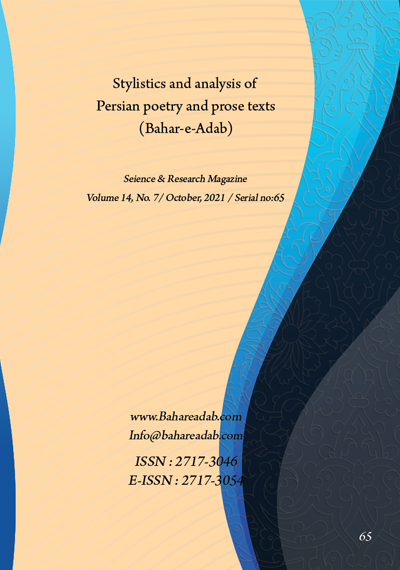- Count View : 378
- آدرس کوتاه شده مقاله: https://bahareadab.com/article_id/1150
- کد doi مقاله: Doi: 10.22034/bahareadab.2021 .14 .5649
Journal of the stylistic of Persian poem and prose
volume Number 14،
number In Volume 7،
،
issue Number 65
Study of slang language elements in Masnavi Manavi (books one to three)
Mahboubeh Heidari (Author in Charge), Saeed Haj Ebrahimi
Abstract
BACKGROUND AND OBJECTIVES: Colloquialism is one of the manifestations of the language system. Some of mystics" audiences were the common people. Mowlana, as a greatest mystic poet of Iran, has widely used colloquial language elements in Masnavi to convey high moral and mystical concepts. The purpose of this research is extraction and analysis of colloquial language elements in books1-3 of Masnavi.
METHODOLOGY: Leading research is a theoretical study conducted in the style of library research. The population was the first to third books of Masnavi.
FINDINGS: Among phonological processes, elimination and mutation had the highest frequency. Nouns including onomatopoeia and nouns related to local accents form the main part of the noun category. In the verb section prefixed verbs, compound verbs and verb phrase which were generally ironical, had the highest frequency. In addition, the main part of the colloquial adjectives is curses, ironical expressions and adjectives belonging to local accents. The clauses especially interjections had also constituted a relatively significant number of the colloquial vocabulary in Masnavi. Adverbs were less common and prepositions, conjunctions, and pronouns have only minor occurrence. There was also a high frequency of proverbs as a symbol of colloquial sentences. In stories based on the charactersthe frequency of colloquialism elements usage is high.
CONCLUSION: Mowlana has used colloquial language elements at three levels of phonological processes, vocabulary, and sentences. He has brought his language closer to the language of the common people in order to arouse the desire of the audience and guide him towards a better understanding of the complex concepts of Masnavi.
Keyword
Mowlana
, Masnavi
, colloquialism
, phonological processes
, vocabulary
, sentence
- Aflaki, S. (1983). Managhebolarefin. Edited by Tahsin Yaziji, T. 1st vol. 1st ed. Tehran: Donyaye Ketab, p. 129.
- Bateni, M. (2007). Description of Persian grammatical structure.20th ed. Tehran: Amirkabir, p. 11.
- Eftekhari, S. (2005). The role of linguistic diligence in the emergence of colloquial Persian. Quarterly Journal of Literary Research, The second period, 7, pp. 25-60.
- Falk, J. (2008). Linguistics & Language, Translated by Bahrami, A. Tehran: Rahnama, p. 81.
- Gölpınarl, A. (1996). Translated by Sobhani, T. 3rd ed. Tehran: Institute of Humanities and Cultural Studies, pp. 421-429
- Mowlana, J. (2007). Fihi Ma Fihi. Edited by Forozanfar, B. 2nd ed. Tehran: Agha, p. 236.
- Najafi, A. (1999). Vulgar Persian Dictionary Volum I. Tehrann: Niloufar, p. 7.
- Natel Khanlari, P. (1986). History of Persian Language Volume II. Tehran: Nashreno, p. 124.
- Pournamdarian, T. (2005). In the shade of the sun. 2nd ed. Tehran: Sokhan, pp. 255-261.
- Rabani, Z. (2012). Persian culture in the Roman Seljuk realm. 1st ed. Tehran: Elmifarhangi, pp. 2-59.
- Shamse Tabrizi, (2012). Maghalat-e Shams, Edited by Movahed.M. 4th ed. Tehran: Kharazmi, p. 225.
- Tavakoli, H. (2015). From the hints of the sea. 3rd ed. Tehran: Morvarid, pp. 282-283.
- Yervish, M. (1984). New linguistics. Translated by Bateni, M. 2nd ed. Tehran: Aghah, p. 26.
- Zamani, K. (2017). Comprehensive description of Masnavi, the first book. 49th ed. Tehran: Ettelaat, pp. 47-1126.
- Zamani, K. (2016). Comprehensive description of Masnavi, third book. 38th ed. Tehran: Ettelaat, pp. 21-1221.
- Zamani, K. (2017). Comprehensive description of Masnavi, second book. 38th ed. Tehran: Ettelaat, pp. 17-930.
- Zarrinkob, A. (2007). The Mystery of Ney. 1st vol. 11th ed. Tehran: Elmi, pp. 108-229.

